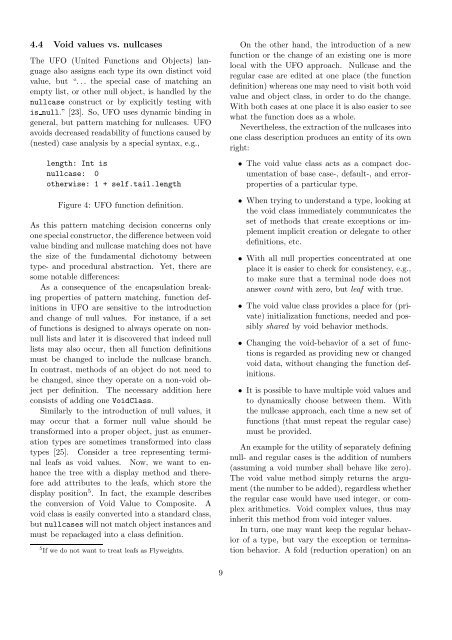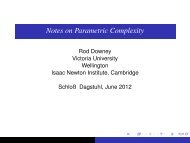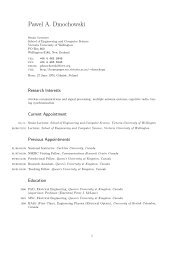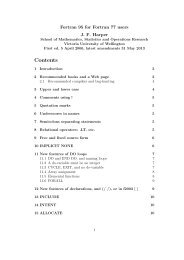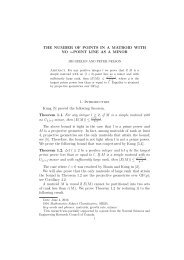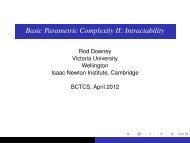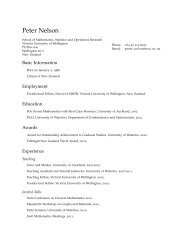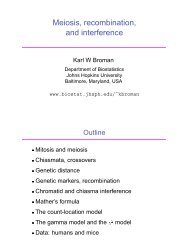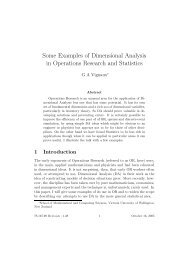Nil and None considered Null and Void - School of Engineering and ...
Nil and None considered Null and Void - School of Engineering and ...
Nil and None considered Null and Void - School of Engineering and ...
You also want an ePaper? Increase the reach of your titles
YUMPU automatically turns print PDFs into web optimized ePapers that Google loves.
4.4 <strong>Void</strong> values vs. nullcases<br />
The UFO (United Functions <strong>and</strong> Objects) language<br />
also assigns each type its own distinct void<br />
value, but “. . . the special case <strong>of</strong> matching an<br />
empty list, or other null object, is h<strong>and</strong>led by the<br />
nullcase construct or by explicitly testing with<br />
is null.” [23]. So, UFO uses dynamic binding in<br />
general, but pattern matching for nullcases. UFO<br />
avoids decreased readability <strong>of</strong> functions caused by<br />
(nested) case analysis by a special syntax, e.g.,<br />
length: Int is<br />
nullcase: 0<br />
otherwise: 1 + self.tail.length<br />
Figure 4: UFO function definition.<br />
As this pattern matching decision concerns only<br />
one special constructor, the difference between void<br />
value binding <strong>and</strong> nullcase matching does not have<br />
the size <strong>of</strong> the fundamental dichotomy between<br />
type- <strong>and</strong> procedural abstraction. Yet, there are<br />
some notable differences:<br />
As a consequence <strong>of</strong> the encapsulation breaking<br />
properties <strong>of</strong> pattern matching, function definitions<br />
in UFO are sensitive to the introduction<br />
<strong>and</strong> change <strong>of</strong> null values. For instance, if a set<br />
<strong>of</strong> functions is designed to always operate on nonnull<br />
lists <strong>and</strong> later it is discovered that indeed null<br />
lists may also occur, then all function definitions<br />
must be changed to include the nullcase branch.<br />
In contrast, methods <strong>of</strong> an object do not need to<br />
be changed, since they operate on a non-void object<br />
per definition. The necessary addition here<br />
consists <strong>of</strong> adding one <strong>Void</strong>Class.<br />
Similarly to the introduction <strong>of</strong> null values, it<br />
may occur that a former null value should be<br />
transformed into a proper object, just as enumeration<br />
types are sometimes transformed into class<br />
types [25]. Consider a tree representing terminal<br />
leafs as void values. Now, we want to enhance<br />
the tree with a display method <strong>and</strong> therefore<br />
add attributes to the leafs, which store the<br />
display position 5 . In fact, the example describes<br />
the conversion <strong>of</strong> <strong>Void</strong> Value to Composite. A<br />
void class is easily converted into a st<strong>and</strong>ard class,<br />
but nullcases will not match object instances <strong>and</strong><br />
must be repackaged into a class definition.<br />
5 If we do not want to treat leafs as Flyweights.<br />
On the other h<strong>and</strong>, the introduction <strong>of</strong> a new<br />
function or the change <strong>of</strong> an existing one is more<br />
local with the UFO approach. <strong>Null</strong>case <strong>and</strong> the<br />
regular case are edited at one place (the function<br />
definition) whereas one may need to visit both void<br />
value <strong>and</strong> object class, in order to do the change.<br />
With both cases at one place it is also easier to see<br />
what the function does as a whole.<br />
Nevertheless, the extraction <strong>of</strong> the nullcases into<br />
one class description produces an entity <strong>of</strong> its own<br />
right:<br />
• The void value class acts as a compact documentation<br />
<strong>of</strong> base case-, default-, <strong>and</strong> errorproperties<br />
<strong>of</strong> a particular type.<br />
• When trying to underst<strong>and</strong> a type, looking at<br />
the void class immediately communicates the<br />
set <strong>of</strong> methods that create exceptions or implement<br />
implicit creation or delegate to other<br />
definitions, etc.<br />
• With all null properties concentrated at one<br />
place it is easier to check for consistency, e.g.,<br />
to make sure that a terminal node does not<br />
answer count with zero, but leaf with true.<br />
• The void value class provides a place for (private)<br />
initialization functions, needed <strong>and</strong> possibly<br />
shared by void behavior methods.<br />
• Changing the void-behavior <strong>of</strong> a set <strong>of</strong> functions<br />
is regarded as providing new or changed<br />
void data, without changing the function definitions.<br />
• It is possible to have multiple void values <strong>and</strong><br />
to dynamically choose between them. With<br />
the nullcase approach, each time a new set <strong>of</strong><br />
functions (that must repeat the regular case)<br />
must be provided.<br />
An example for the utility <strong>of</strong> separately defining<br />
null- <strong>and</strong> regular cases is the addition <strong>of</strong> numbers<br />
(assuming a void number shall behave like zero).<br />
The void value method simply returns the argument<br />
(the number to be added), regardless whether<br />
the regular case would have used integer, or complex<br />
arithmetics. <strong>Void</strong> complex values, thus may<br />
inherit this method from void integer values.<br />
In turn, one may want keep the regular behavior<br />
<strong>of</strong> a type, but vary the exception or termination<br />
behavior. A fold (reduction operation) on an<br />
9


